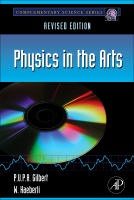Welcome
Welcome to the website for Gilbert, Haeberli: Physics in the Arts: Revised Edition, 1st Editionst Edition.
Physics in the Arts
About This Companion Site
Ever since the course Physics in the Arts was introduced by Profs Ugo Camerini and Willy Haeberli at the University of Wisconsin in the early 1970s, laboratory exercises were made an integral part of the course. Initially, many doubtedthat a history major could learn to use an oscilloscope, a Fourier analyzer, or a spectrophotometer, but in recent years use of computers has changed the picture. However, to this day we find it important to avoid frustration among the students by providing ready access to a sympathetic teaching assistant in the 2-hour laboratory sessions. The luxury of the initial small 12-student laboratory groups has in the meantime given way to economic reality with present 16 groups of 18 students working in pairs, with 4 TAs and two professors per semester. We have a pool of 5 professors alternating in teaching this course. The laboratory exercises are described in a manual which the students more or less follow—they are encouraged to deviate from the prescribed exercises but they rarely do. Each student records his/her lab work in a bound quadrille notebook, which is kept in the laboratory.
Here we give a short description of the laboratory experiments for the Physics in the Arts course at the UW-Madison. Depending on the preference of the professor in charge of the course, the chapters in Sound (Chapters 10-21) may be covered before the chapters on Light (Chapters 1-9). We recommend not planning labs during any incomplete weeks (the first or the last week of class), during Thanksgiving week, or spring break, and not scheduling labs the week of the mid-term exams, otherwise some students will have done the lab and others will not at the time of the exam, and this is obviously unfair.We recommend doing the labs after the related lectures, and after the related homework has been turned in. These labs are considerably different from the lecture demonstrations, and in many cases are the only chance in the lifetime of a liberal arts student to do hands-on measurement.
Laboratory Experiments
- lab1 (569KB Adobe Acrobat file)
- lab2 (140KB Adobe Acrobat file)
- lab3 (27KB Adobe Acrobat file)
- lab4 (152KB Adobe Acrobat file)
- lab5 (147KB Adobe Acrobat file)
- lab6New in March 2012 (302KB Adobe Acrobat file)
- lab7New in March 2012 (492KB Adobe Acrobat file)
- lab8New in March 2012 (297KB Adobe Acrobat file)
- lab9New in March 2012 (306KB Adobe Acrobat file)
- lab10New in March 2012 (41KB Adobe Acrobat file)
- lab11New in March 2012 (78KB Adobe Acrobat file)
- lab12New in March 2012 (48KB Adobe Acrobat file)
Figures for Teaching
- Chapter 001 (1076KB Zip File)
- Chapter 002 (1857KB Zip File)
- Chapter 003 (1695KB Zip File)
- Chapter 004 (327KB Zip File)
- Chapter 005 (1565KB Zip File)
- Chapter 006 (2025KB Zip File)
- Chapter 007 1 (2662KB Zip File)
- Chapter 007 2 (2644KB Zip File)
- Chapter 007 3 (2553KB Zip File)
- Chapter 008 (1614KB Zip File)
- Chapter 009 (5559KB Zip File)
- Chapter 009 1 (2716KB Zip File)
- Chapter 009 2 (2843KB Zip File)
- Chapter 010 (439KB Zip File)
- Chapter 011 (324KB Zip File)
- Chapter 012 (893KB Zip File)
- Chapter 013 (1034KB Zip File)
- Chapter 014 (1185KB Zip File)
- Chapter 015 (265KB Zip File)
- Chapter 016 (440KB Zip File)
- Chapter 017 (860KB Zip File)
- Chapter 018 (799KB Zip File)
- Chapter 019 (1308KB Zip File)
- Chapter 020 (84KB Zip File)
- Chapter 021 (150KB Zip File)
- Chapter 022 (2765KB Zip File)
Jpeg
Disclaimer
Information provided in this document is provided "as is" without warranty of any kind, either express or implied. Every effort has been made to ensure accuracy and conformance to standards accepted at the time of publication. The reader is advised to research other sources of information on these topics.
The user assumes the entire risk as to the accuracy and the use of this document. This document may be copied and distributed subject to the following conditions:
All text must be copied without modification and all pages must be included;
All copies must contain the appropriate copyright notice and any other notices provided therein; and
This document may not be distributed for profit.
